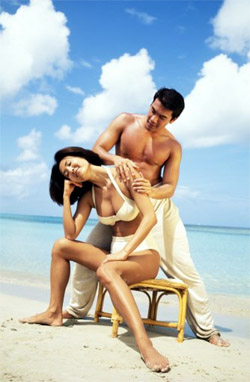Dec 24, 2025
Dec 24, 2025
 Massage has been used as a remedial measure from centuries. Massaging causes various physiological effects which comfort the body. Manually kneading or manipulating the soft tissues to relieve pain, discomfort, stress and to promote health and wellness is called as -'massage'. The techniques of massage to promote health and wellness are called 'Massage Therapy'.
Massage has been used as a remedial measure from centuries. Massaging causes various physiological effects which comfort the body. Manually kneading or manipulating the soft tissues to relieve pain, discomfort, stress and to promote health and wellness is called as -'massage'. The techniques of massage to promote health and wellness are called 'Massage Therapy'.
The American Massage Therapy Association (AMTA) defines Massage therapy as a profession in which the practitioner applies manual techniques, and may apply adjunctive therapies, with the intention of positively affecting the health and well-being of the client."
Massage therapy (Abhyanga) is recommended in Ayurveda in the course of treating several diseases. It plays a great role in body detoxification process (Panchakarma) before starting the core treatment. Usually, Ayurvedic herbal oils or aromatic oils are used during massage. The oils are selected according to the condition and objective of massage.
Types of Body Massage
Different kinds of body massage are adopted after analyzing the cause and location of discomfort. The following are the various kinds of body massage.
Techniques of Massage
A massage therapist uses Strokes and Pressure while massaging. Effleurage, Petri sage, Percussion, Friction and Vibration are 5 different strokes used while massaging.
Effleurage strokes are long, gliding and soothing. These strokes are made with flat surface of hands. Effleurage strokes increase the circulation and depth of relaxation.
Petri sage strokes resemble kneading. These strokes are recommended to massage children and elderly people. Skin and muscle surface are rolled or squeezed, gently and firmly by grasping them between thumb and fingers.
Percussion is done using both hands. In this stroke both hands move rapidly and alternatively stimulating the muscles. Percussion can be done with finger tips (tapping), chopping movement of stretched fingers (hacking), cupped hands (cupping), flat opened palms (slapping), and using both fists (pounding).
Friction: These strokes are used to treat joints and surrounding areas. Friction breaks adhesions, remove wastes and clean up congestion. Long, slow, firm strokes or circular movements of hand are used to move superficial tissues over the deep underlying tissues.
Vibrations : These strokes stimulate nerves. Hands or fingers are moved back and forth rapidly on soft tissues to shake them. Vibrations are used on buttocks, thighs, upper back etc.
Mild, moderate or heavy Pressure is applied during massage, depending upon the part to be massaged and the aim of massage.
The texts of Ayurveda illustrate different types of massages for different conditions. They are
Udvarthana
Massaging body in opposite direction (According to Ayurvedic texts, starting the massage from the head and proceeding downwards is considered conventional. Hence, massages that proceed from palm to shoulder or Feet to thighs or hips to neck are opposite in direction.) These massages are performed by exerting little pressure using dry herbs. This kind of massage exfoliates skin, enhances its glow and gives healthy look. It also helps to reduce bad odor which is caused due to sweat.
Mardana
Massaging the whole body exerting more pressure is called Mardana. This is usually done for persons who indulge in enhanced physical work e.g. athletes, sports persons, Wrestlers etc.
Paadaghata
Padaaghata means massaging using the feet, Trampling the body with required pressure is called padaghata.
Benefits of Massage Therapy
According to ayurveda massaging body daily with ayurvedic herbal oil has innumerable benefits. This process is called as "Abhyanga". In great ayurvedic classic Ashtanga Hridaya the benefits of herbal oil massage has been documented as follows.
" Abhyanga aachare nityam sa jara- shrama vataha |
Drushtihi prasada pushtyaahu swapna sutwak daadarya krit || "
Acharya Charaka indicates foot massage (Padabhyanga) to get rid of cracked feet, dry skin on foot, to relieve tiredness and foot pain. The flexibility of foot increases.
Precautions and Prohibitions
According to ayurvedic texts the massage should not be done for those who suffer from fever, diarrhea, vomiting and indigestion and in pregnancy.
Usually therapists do not massage a person if the latter has, fever, skin eruptions, large bruises, inflamed joints, sensitive veins, varicose, tumors, a period, indigestion, nut allergy, appendix: 2yr/6m, dislocated shoulder(s), vertebral problems. The person should not wear contact lenses or consume alcohol or over-eat during or shortly before a massage.
One more precaution to be taken before going for a massage is to check whether the massage therapist is qualified or not. An unqualified massage therapist may cause more harm than relief.
Dr.Savitha Suri has been an Ayurvedic Practitioner since 1989. After getting a graduation degree in Ayurveda (Bachelor of Ayurvedic Medicine and Surgery) in 1988 from University of Mysore, India, she started practicing Ayurveda . Her articles about Ayurveda have been published in news papers, health magazines and websites. Dr.Savitha Suri lives in Mysore, Karnataka, India. She gives consultations in Mysore and also in Bangalore, the silicon valley of India. By arrangement with http://www.ayurhelp.com
Disclaimer:
Information provided in this article is for the sole purpose of imparting education on Ayurveda and is not intended to diagnose, treat, cure or prevent any disease. If you have a medical condition, please consult your physician.
19-May-2007
More by : Dr. Savitha Suri